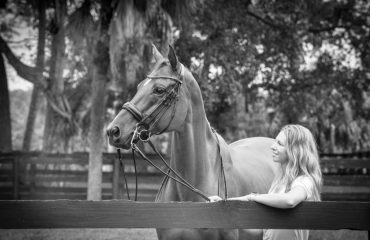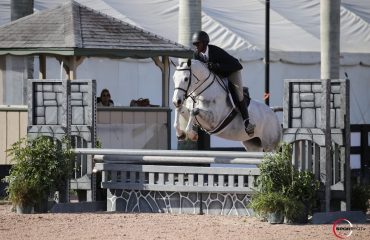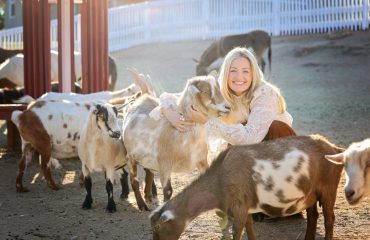By Kerstie Allen
Polo grooms. There would be no polo without them. These behind-the-scenes workaholics have a true passion for polo.
If you like to work with horses and are interested in polo, becoming a groom is a great way to get involved. This season, I decided not to play, and give my body a rest and focus on my horses. I decided to lease my string of polo horses to a friend to play low-goal polo. This way, my horses and I could take a break from the pressure but I could still take care of my horses and be around polo.

A regular day of grooming consists of being greeted by several rowdy, fire-breathing ponies who act like fierce, starving monsters while they whinny, kick, paw and bite the air as they impatiently wait to be fed their breakfast. Once there’s finally peace in the barn, it’s time to clean out stalls while they’re focused on eating.
It’s 5 a.m., 10 hours before game time, but just enough time to prepare a string of ponies for their weekend appearance. First we clean them up and get them out of their stalls for some exercise. I halter and wrap their front legs for protection and saddle one horse. As I have 10 horses to exercise and only so many hours in the day, I take out a set.
A set is when you ride one horse and lead or “pony” another horse or two. In the polo world, we ride one and lead two, three, four or more at one time. This is a skill that requires coordination and endless failed attempts. Like all horses, each one has a unique personality; some only like to be led from one side, not everyone gets along, some refuse to be led and after a time or two of rope-burn on my hands, I volunteer one to be the “pony” horse — the one that will be ridden during the next set.
After juggling five horses while I mount, we head out to the track to do a few laps. This is where the true difference between a groom, an amateur and knowing your horses comes into play. The track has several other grooms with sets all going at different speeds. Trying to maneuver five horses around a sometimes unfriendly track of low branches, mud puddles and the occasional spooky shadow while also attempting to adjust your reins as your hand is cramping from holding four lead ropes while you snapchat and take selfies on your phone … will test all of your skills.
After arriving back safely at the wash rack, we all rinse off. Somehow I always get more wet than the horses I’m hosing off but it’s a refreshing moment before I head out with my next set. I’ve been doing this every day for over a month now to get ready for the start of the playing season.
 When all the horses are returned to their stalls, it’s time to clean tack and roll wraps. Ten full polo bridles with running reins and martingales, six saddles with breast collars and syringes and forty wraps later … I wish I had a passion for a one-horse sport! Two hours before game time, it’s time to hook up the truck and trailer, load the ponies and tack and head to the field. In polo we use our trailers as a hitching rail and mobile tack room so we can park and work field-side at our team’s end of the polo field. Most trailers have saddle racks on the tack room doors, several bridle racks and a huge water tank to wash the horses after they play. It usually takes about an hour to wrap legs and braid tails to prepare for the start of a game.
When all the horses are returned to their stalls, it’s time to clean tack and roll wraps. Ten full polo bridles with running reins and martingales, six saddles with breast collars and syringes and forty wraps later … I wish I had a passion for a one-horse sport! Two hours before game time, it’s time to hook up the truck and trailer, load the ponies and tack and head to the field. In polo we use our trailers as a hitching rail and mobile tack room so we can park and work field-side at our team’s end of the polo field. Most trailers have saddle racks on the tack room doors, several bridle racks and a huge water tank to wash the horses after they play. It usually takes about an hour to wrap legs and braid tails to prepare for the start of a game.
There are six chukkas, each approximately seven minutes long, in a game — just barely enough time to untack one horse, tack up another, rinse off and walk the hot horse and get the next horse warmed up and field-side before the end of the chukka whistle. In higher-level polo, we hire “game help.” These are often friends, family or other grooms that don’t have games on the same day who will help tack up or untack,
walk and wash hot horses and often will hold a spare horse and mallet at one end of the field in case a player breaks a mallet or needs an extra fresh horse during the game.
Returning to the barn at dusk, the ponies are happy to return to their stalls for their evening meal. It’s been a long day for everyone. Grooming is sometimes a thankless job — especially if, for some reason, your team loses. But to share the joy of a win always seems to make the 24/7 workload worthwhile.
A high-level groom has to have self-driven motivational skills, an eye for detail and a heart for horses. Whether they’re your horses or not, after months of talking to them like they’re your best friends and taking care of their every need, like a preschool child, they’ve become like family members. You know each horse’s good and bad habits, from every look to literally every bowel movement.
Grooming is not a four-year college course. It takes many more years and endless hours of dedication in the barn to even think of possibly mastering the art of grooming. If you’re a good groom, your horses will shine and give their best and at the end of the day, win or lose, your string of ponies will make you proud.
As my mum says, “This is one girl who’d rather clean stalls than her room.”
About the writer: Kerstie Allen is a native of Melbourne, Australia. Her passion for horses has taken her on a worldwide adventure exploring and mastering nearly every discipline in the equestrian world and opening doors of opportunity for women everywhere. Follow Kerstie’s adventures at: Twitter: @kerstiea; Facebook fan page: Kerstie Allen; and Instagram: allenkerstie.












